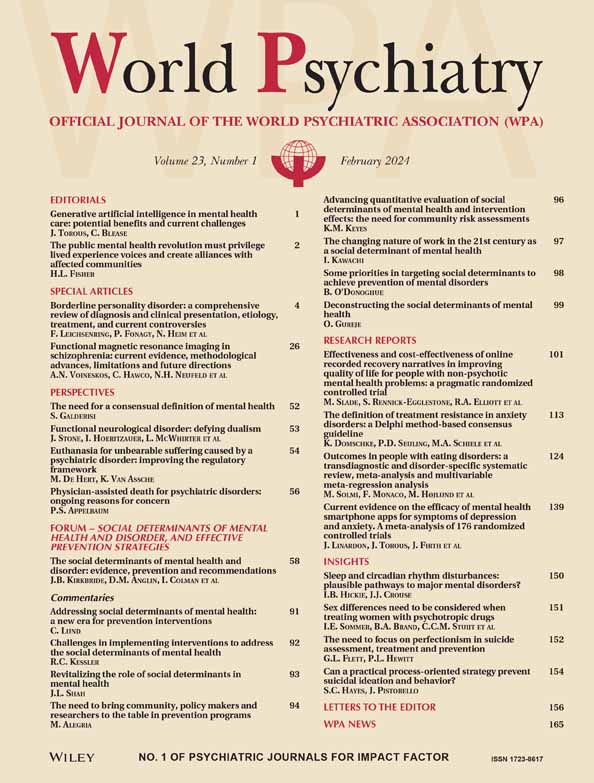费城神经发育队列中精神病谱系症状的持续:一项前瞻性两年随访
IF 65.8
1区 医学
Q1 PSYCHIATRY
引用次数: 98
摘要
对有早期精神病样经历的年轻人进行前瞻性评估可以丰富我们对临床、生物行为和环境风险以及与精神病障碍发展相关的保护因素的了解。我们旨在通过第一项评估社区亚临床症状的大型系统研究,调查美国青年精神病谱系特征持续或恶化的预测因素。根据时间1对费城神经发育队列中9498名青年(8-21岁)的筛查,根据基线精神病谱系症状的存在(N=249)或不存在(N=254)、先前参与神经影像学和当前神经影像学资格,招募了一个子样本参与者。他们被邀请在时间1之后平均两年参加时间2评估。参与者接受了前驱综合征结构化访谈,对最初的筛查状态视而不见,同时进行了分裂型人格问卷和其他临床测量、计算机神经认知测试和神经成像。使用逻辑回归检验症状持续性的临床和人口统计学预测因素。在时间2,51.4%的年轻人的精神病谱系特征持续存在或恶化。亚临床精神病的严重程度越高,整体功能越低,基线时既往接受过精神药物治疗,可以预测症状的持续性。尽管在基线时被归类为有精神病谱系症状但在随访时没有的年轻人在基线和随访时表现出相对较高的症状水平和较低的功能,但与典型的发展中的年轻人相比。此外,精神病谱系特征出现在少数年轻人身上,这些年轻人以前没有报告过显著症状,但表现出早期临床警告信号。总之,我们的研究结果表明,不同病程的精神病谱系症状在美国青年早期很明显,这支持了将精神病风险作为一个动态发展过程进行调查的重要性。神经认知、大脑结构和功能以及基因组学可以与临床数据相结合,为有精神病风险的年轻人提供症状持续性和恶化的早期指标。本文章由计算机程序翻译,如有差异,请以英文原文为准。
Persistence of psychosis spectrum symptoms in the Philadelphia Neurodevelopmental Cohort: a prospective two‐year follow‐up
Prospective evaluation of youths with early psychotic‐like experiences can enrich our knowledge of clinical, biobehavioral and environmental risk and protective factors associated with the development of psychotic disorders. We aimed to investigate the predictors of persistence or worsening of psychosis spectrum features among US youth through the first large systematic study to evaluate subclinical symptoms in the community. Based on Time 1 screen of 9,498 youth (age 8‐21) from the Philadelphia Neurodevelopmental Cohort, a subsample of participants was enrolled based on the presence (N=249) or absence (N=254) of baseline psychosis spectrum symptoms, prior participation in neuroimaging, and current neuroimaging eligibility. They were invited to participate in a Time 2 assessment two years on average following Time 1. Participants were administered the Structured Interview for Prodromal Syndromes, conducted blind to initial screen status, along with the Schizotypal Personality Questionnaire and other clinical measures, computerized neurocognitive testing, and neuroimaging. Clinical and demographic predictors of symptom persistence were examined using logistic regression. At Time 2, psychosis spectrum features persisted or worsened in 51.4% of youths. Symptom persistence was predicted by higher severity of subclinical psychosis, lower global functioning, and prior psychiatric medication at baseline. Youths classified as having psychosis spectrum symptoms at baseline but not at follow‐up nonetheless exhibited comparatively higher symptom levels and lower functioning at both baseline and follow‐up than typically developing youths. In addition, psychosis spectrum features emerged in a small number of young people who previously had not reported significant symptoms but who had exhibited early clinical warning signs. Together, our findings indicate that varying courses of psychosis spectrum symptoms are evident early in US youth, supporting the importance of investigating psychosis risk as a dynamic developmental process. Neurocognition, brain structure and function, and genomics may be integrated with clinical data to provide early indices of symptom persistence and worsening in youths at risk for psychosis.
求助全文
通过发布文献求助,成功后即可免费获取论文全文。
去求助
来源期刊

World Psychiatry
医学-精神病学
自引率
7.40%
发文量
124
期刊介绍:
World Psychiatry is the official journal of the World Psychiatric Association. It is published in three issues per year.
The journal is sent free of charge to psychiatrists whose names and addresses are provided by WPA member societies and sections.
World Psychiatry is also freely accessible on Wiley Online Library and PubMed Central.
The main aim of World Psychiatry is to disseminate information on significant clinical, service, and research developments in the mental health field.
The journal aims to use a language that can be understood by the majority of mental health professionals worldwide.
 求助内容:
求助内容: 应助结果提醒方式:
应助结果提醒方式:


